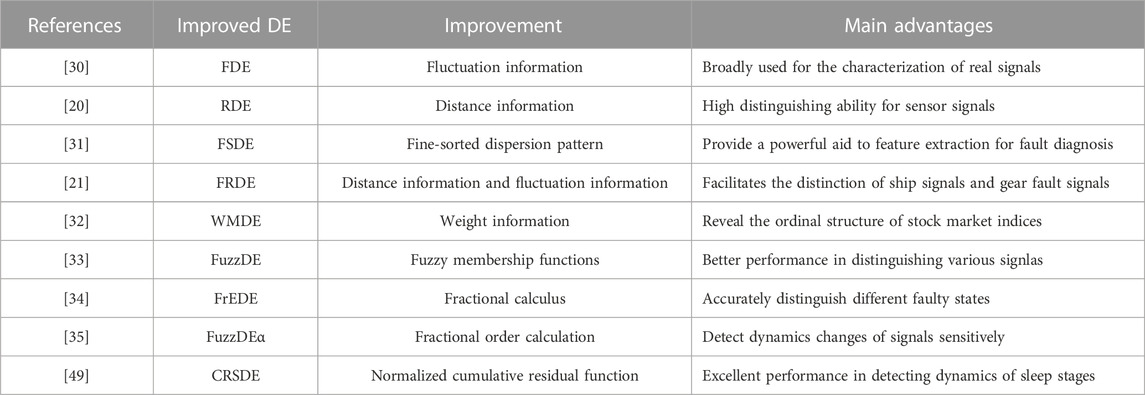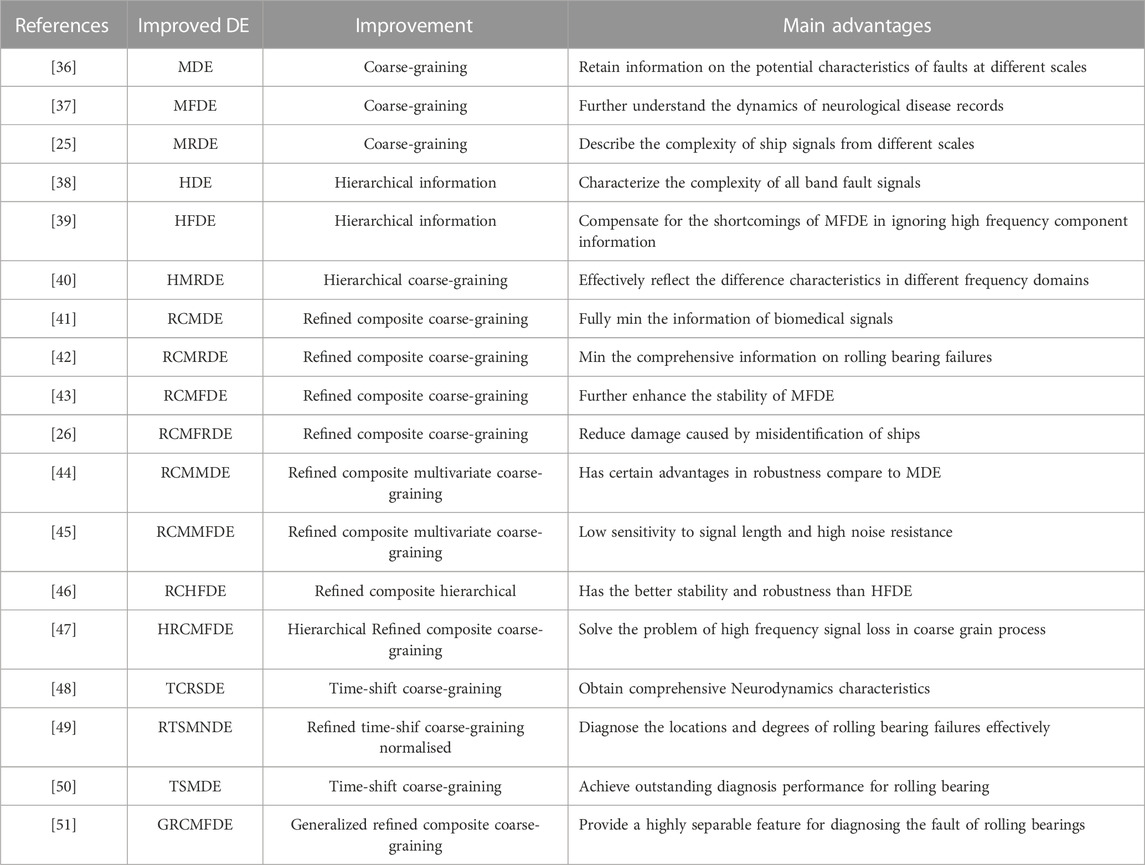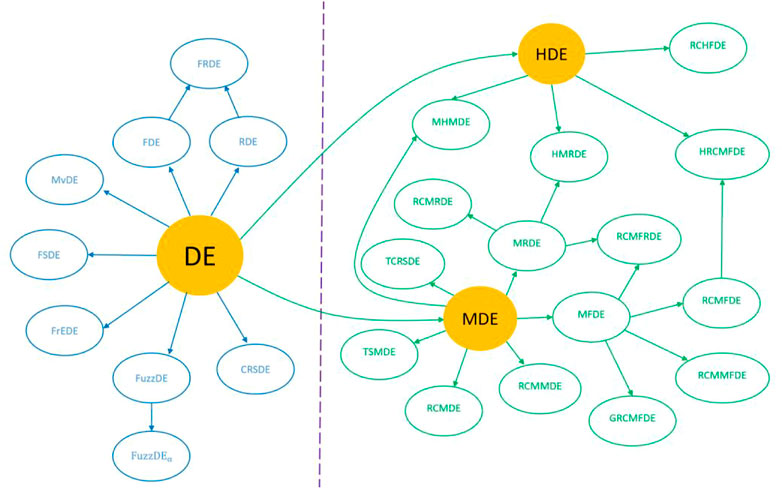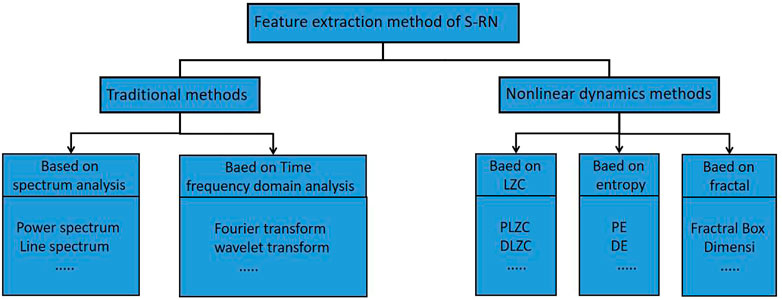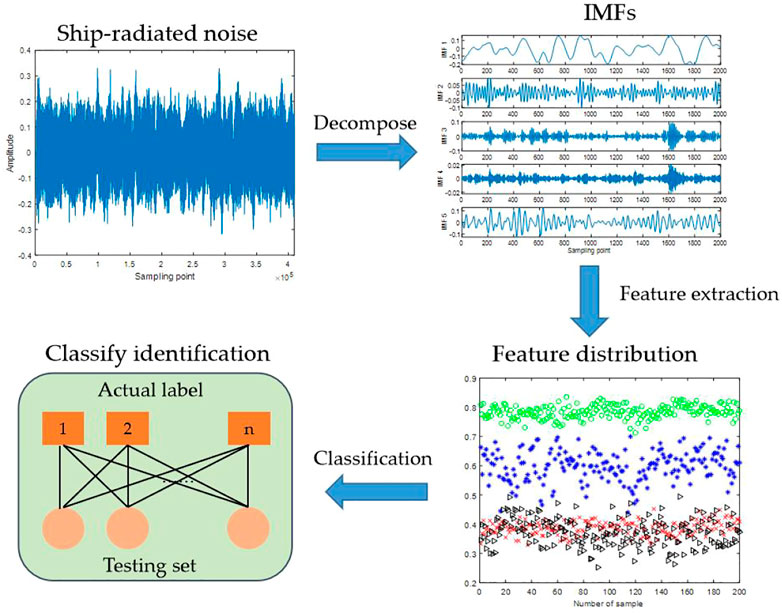- Xi’an Traffic Engineering Institute, Xi’an, China
There is abundant ship information in ship-radiated noise, which is helpful for ship target recognition, classification and tracking. However, owing to the increasing complexity of the marine environment, it makes difficult to extract S-RN features. Dispersion entropy has been proven to be an excellent method to extract the features of S-RN by analyzing the complexity of S-RN, and has been widely used in feature extraction of S-RN. This paper summarizes the research progress of DE in the feature extraction of S-RN in recent years, and provides a comprehensive reference for researchers related to this topic. First, DE and its improved algorithm are described. Then the traditional and DE-based S-RN feature extraction methods are summarized, and the application of DE in S-RN feature extraction methods is concluded from two aspects: methods that apply DE algorithms only and methods that combine DE with mode decomposition algorithms. Finally, the research prospects of DE and the summary of this paper are given.
1 Introduction
In the ocean, sound waves are an effective way to transmit information over long distances. Ship-radiated noise (S-RN) is a good marine sound source, which is of great significance to ship navigation safety and marine exploration [1, 2]. However, the ocean is always accompanied by a large amount of environmental noise, which is a huge interference to the reception and recognition of S-RN. How to effectively extract the features of S-RN has become a hot issue [3, 4].
The traditional feature extraction method for S-RN mainly has two types: 1) feature extraction method based on spectrum analysis. The S-RN is analyzed by the spectrum, and the line spectrum feature and shape feature of power spectrum in S-RN are extracted [5]. 2) Feature extraction method based on time-frequency domain analysis. The features of the S-RN are extracted by Fourier transform [6], wavelet transform [7] and Hilbert-Huang transform [8], and so on. Although these methods achieved some results, the identification of S-RN in practical applications still cannot meet the expected requirements.
Recently, some nonlinear dynamical methods have achieved better results in feature extraction, such as Lempel-Ziv complexity (LZC) [9], fractal dimension [10], entropy [11]. LZC has been successfully applied to feature extraction of S-RN, such as permutation LZC (PLZC) [12], dispersion LZC (DLZC) [13, 14] and DE-based LZC (DELZC) [15], but it has high requirements for the length of time series, and its over-dependence on pattern conversion also limits the ability of LZC to characterize signals. Compared with LZC, the fractal dimension is suitable for processing various types of nonlinear and nonstationary signals like S-RN [16], but this excellent effect costs a lot of time; in addition, there are only a few types of fractal dimensions, such as box dimension [9, 17], so the application of fractal method to extract discriminant features has not been thoroughly studied. Last but not least, for entropy, the development in feature extraction of S-RN is more comprehensive and faster than LZC and fractal dimension, and recently proposed entropy in common use are PE [18–20], DE [21–23] and slope entropy [24–26]. However, the PE cannot reflect the amplitude change information of S-RN, and slope entropy is seriously affected by threshold setting, and the characteristic value is sufficiently enough. DE is the most widely used in S-RN feature extraction because of the absence of these defects. In general, compared with other entropies, LZC and fractal dimension, DE has higher computational efficiency and deeper stability, and there are richer research results of DE in feature extraction of S-RN.
The DE-based method has been widely used in feature extraction of S-RN and has shown superior performance. In this paper, we will give a comprehensive review of the DE-based methods and divide them into two types: methods that apply DE algorithms only [27, 28] and methods that combine DE with mode decomposition algorithms [23, 29]; then we introduce two aspects of DE in and its application for S-RN. The rest of this review is structured as follows. Section 2 introduces the DE and its improved algorithm. Section 3 describes the traditional S-RN feature extraction methods and the S-RN feature extraction method based on DE, and summarizes the relevant applications. The prospects of DE in the feature extraction method for S-RN are presented in Section 4. Section 5 gives the conclusion of this review.
2 Theory of dispersion entropy
2.1 DE algorithm
DE [30] is one of the important indexes to evaluate the complexity of time series, which considers the relationship between amplitudes, and has strong robustness and fast operability. The specific calculation steps are as follows:
Step 1: For a given time series
where
Step 2: The series
where
Step 3: The sequence
where
Step 4: Each component is labeled as a dispersion pattern
where
and the normalized DE (NDE) can be defined as:
2.2 Improved DE algorithm
Since DE has excellent ability to represent signal complexity, many scholars have improved DE to improve the performance of DE, such as reverse DE (RDE), multiscale DE (MDE), and so on. According to the different ways of DE improvement, the improved dispersion entropy is mainly divided into two categories: 1) the improvement of DE steps; and 2) the preprocessing of DE.
To enhance the capacity of DE to characterize the complexity of signals, some scholars are committed to optimizing the calculation steps of DE, and various upgraded versions of DE have been advanced. Azami et al. [31] developed the fluctuation-based DE (FDE) by considering the fluctuation of signals, which provides a powerful tool for analyzing fluctuating signals. Li et al. [21] introduced distance information to DE, the reverse DE (RDE) is raised and demonstrates high stability when analyzing various sensor signals. To address the problem that DE is insensitive to information perception between adjacent elements of time series [32], proposed the fine-sorted DE (FSDE) by adding an additional factor to fine sort the normalized elements. Inspired by FDE and RDE, Jiao et al. [22] combined the advantages of FDE and RDE to propose fluctuation-based reverse DE (FRDE), and this operation further improved the stability and separability of DE. In 2021, the weighted multivariate DE (WMDE) was proposed [33] by integrating multivariate analysis and weighted calculation, which is more sensitive to signal changes and stable. In view of the problem of DE instability due to amplitude variation, Rostagh et al. [34] introduced a fuzzy membership function into DE and developed fuzzy DE (FuzzDE), which improves the performance of DE in detecting frequency changes and periodic changes. Influenced by fractional order calculation [35,36] proposed fractional extended DE (FrEDE) and fractional order fuzzy DE (FuzzDEα) respectively. In addition, Wang et al. [11] advanced a normalized cumulative residual function (NCRF) to magnify the difference between dispersion patterns, and give the give the definition of cumulative residual symbolic DE (CRSDE), which realizes the representation of more effective pattern information. In summary, these improved algorithms can represent more abundant feature information and have higher anti-noise ability. The overview of improved DE algorithms based on DE steps are shown in Table 1.
Several improved DE algorithms have been proposed by preprocessing the signals to enhance the performance of DE. Zhang et al. [37] proposed MDE by introducing coarse-graining on the basis of DE to retain information on the potential characteristics of faults at different scales. Azami et al. [38] and Li et al. [27] also introduced coarse graining to RDE and FDE, and proposed multiscale FDE (MRDE) and multiscale FDE (MFDE), respectively, which describe the complexity of signals from different scales. In addition [39,40] introduced hierarchical information and proposed hierarchical DE (HDE) and hierarchical FDE (HFDE) respectively to characterize the complexity of all band signals. Xing et al. [41] combined the concepts of hierarchy and multiscale to propose the hierarchical multiscale RDE (HMRDE), which reflects the effective information of the bearing signal from both hierarchical and scaling perspectives. To represent the comprehensive information on signals, Azami et al. [42] proposed refined composite MDE (RCMDE), which is a refined composite multiscale processing based on DE. The proposed RCMDE not only solves the single-scale problem of DE, but also improves the stability of traditional coarse graining. Inspired by RCMDE, some scholars immediately proposed refined composite MFDE (RCMFDE) [43], refined composite RDE (RCMRDE) [44], and refined composite multiscale FRDE (RCMFRDE) [28], respectively. Referring to the experience that fine composite processing can effectively represent signal complexity, some scholars introduced multivariate theory based on refined composite multiscale processing, and proposed refined composite multiscale multivariate MDE (RCMMDE) [45] and refined composite multiscale multivariate FDE (RCMMFDE) [46], which have low sensitivity to signal length and high noise resistance. As the advantages of fine composite multiscale processing and hierarchical analysis have been recognized, refined composite HFDE (RCHFDE) [47] and hierarchical refined composite MFDE (HRCMFDE) [48] have been proposed respectively, which solve the problem of high frequency signal loss in coarse-graining process. Last but not least, some scholars have also proposed some other improved algorithms, such as time-shift multiscale cumulative residual symbolic (DE) TCRSDE [49], refined time-shift multiscale normalised DE (RTSMNDE) [11], time-shift MDE (TSMDE) [50], and generalized RCMFDE (GRCMFDE) [51], which all further improve the performance of dispersion entropy. The overview of improved DE algorithms based on preprocessing is listed in Table 2.
Whether the improvement of the DE step or the preprocessing of the DE further improves the performance of the scattering entropy and effectively represents the complexity of the signal. In order to show the development of DE more intuitively, we employ the Figure 1 to show all the improved DE algorithms.
3 Feature extraction methods for S-RN
The feature extraction of S-RN has been a difficult problem in the field of underwater acoustic signal processing due to the complexity of marine environmental noise. To solve this challenge, some S-RN feature extraction methods have been developed, mainly including two types: 1) traditional methods, such as those based on spectrum analysis, or time-frequency domain analysis; and 2) nonlinear dynamic methods, such as those based on fractal, Lempel-Ziv complexity (LZC), or entropy. The overall framework of feature extraction method for S-RN is displayed in Figure 2.
Traditional feature extraction methods have certain limitations when analyzing non-stationary S-RN, and the feature extraction results cannot well reflect the true characteristics of the target signal. While Entropy, LZC and fractal dimension are the mainstream nonlinear dynamic indexes applied to feature extraction of S-RN. However, LZC is limited by the length of time series and binary conversion, and it often needs to be combined with entropy theory to meet the demand of feature extraction, current research includes PLZC, DLZC, and DELZC, which have shown excellent performance in feature extraction. Although the fractal dimension can effectively analyze nonlinear signals such as S-RN, it will consume consumes considerable time, and the feature based on fractal dimension are not sufficiently stable. With the development of entropy theory, the ability of entropy to represent signals has also been improved, which can show more feature information of S-RN. From recent research, it can be seen that PE, DE, and slope entropy are the three main entropies used in feature extraction of S-RN, these entropies get rid of over-dependence on time series length and are more computationally efficient. Among them, DE is particularly convenient and effective, because it overcomes the defect that PE ignores amplitude information and is not limited by threshold parameters like slope entropy. Therefore, we review and summarize the DE-based feature extraction methods in this section.
In this section, the references on feature extraction of S-RN based on DE are listed and summarized as the following two subsections: methods that apply DE algorithms only, and methods that combine DE with mode decomposition algorithms, including empirical wavelet transform (EWT), intrinsic time-scale decomposition (ITD), and variational mode decomposition (VMD). Table 1 provides a brief summary of research articles on applications of DE combined mode decomposition in feature extraction of S-RN, which were published after 2015 to cover the latest contributions since the existing review.
3.1 Feature extraction using only DE algorithm
Due to the high computational efficiency, strong robustness and separability of DE, it has been introduced into the field of feature extraction of S-RN. The main steps of feature extraction for S-RN using only DE are illustrated in Figure 3.
Due to the high computational efficiency, strong robustness and separability of DE, it has been introduced into the field of feature extraction of S-RN in recent years. Li et al. [21] first defined the concept of RDE and take it as a new feature of S-RN, the utilization of RDE realized the accurate classification of three ship signals. In 2020, Li et al. [27] successively proposed MRDE-based feature extraction method and feature extraction method based on MRDE combined with the gray correlation degree (GRD) [52], the studies indicated that MRDE performs better than MDE, MPE and other entropy indexes in characterizing ship feature. In addition, RCMDE-KNN-based classification method of S-RN was raised [53], this method enhances the stability and anti-noise ability of the extracted ship features, and the recognition rate for four types of ships reaches 100%. Jiao et al. [22] presented FRDE and applied it to feature extraction of S-RN, the experimental results show that FRDE feature extraction is more prominent than PE and DE. Based on FRDE and RCMDE [28], proposed a novel feature extraction method of S-RN based on RCMFRDE, the experiments show that the excellent performance for feature extraction and classification of S-RN. Xiao [54] introduced hierarchical DE (HDE) into the underwater acoustic field for the first time, which mines the information hidden in the high frequency band of ship radiated noise. Table 3 reveals the applications of DE in feature extraction of S-RN, in which Rr means recognition rate, MRDE + GRD means MRDE and GRD.
3.2 Feature extraction combining DE with mode decomposition algorithms
The feature extraction methods based on mode decomposition and DE have been widely used in the underwater acoustic field and show excellent performance. Figure 4 displays the main steps of S-RN feature method using DE and mode decomposition.
In recent years, some scholars have proposed many S-RN feature extraction methods based on DE and mode decomposition and achieve better results. Li et al. [29] combined ITD with FDE, and proposed a new S-RN feature extraction method, which achieves more than 95% classification accuracy for ten types of S-RN, realizing effective recognition of S-RN [55]. Improved the ITD and proposed a S-RN feature extraction method combining improved ITD (IITD) with MDE, which further enhanced the effect of feature extraction. Yang et al. [23] presented a novel a S-RN feature extraction technology using VMD and FDE, and the results presented that the presented technique has better separation effect and higher discrimination. Li et al [56]. Applied extreme-point symmetric mode decomposition (ESMD) to decompose the S-RN, extracted the DE of intrinsic mode functions (IMFs), and effectively distinguished different types of S-RN. [57] developed a S-RN feature extraction method based on EWT and RDE, and the results reveled that EWT not only has better decomposition performance than empirical mode decomposition (EMD), ensemble empirical mode decomposition (EEMD), and VMD, but also RDE has better separability than PE, RPE and DE; in addition, the recognition rate of the proposed method is higher than 95% for four kinds of S-RN. Yang et al. [58] put forward a S-RN feature method based on complete ensemble empirical mode decomposition with adaptive selective noise (CEEMDANSN) and RCMFDE, which effectively solves the problem of information loss in feature extraction of ship signals. Li et al. [59] and Liu et al [60] used VMD to decompose the S-RN, and extracted the MDE and WFDE of IMFs respectively, which effectively extract the features of S-RN, and the recognition rate is higher than 90%. Table 4 exhibits the applications of DE combined mode decomposition in feature extraction of S-RN, in which Rr means recognition rate, ITD + FDE means ITD and FDE, VMD + FDE means VMD and FDE.
4 Prospects of DE in feature extraction method for S-RN
Based on the above research, we can find that traditional feature extraction methods for S-RN have great limitations, and cannot effectively reflect the real characteristics of S-RN; moreover, compared with other nonlinear dynamic indexes such as LZC and fractal dimension, DE can better represent the complexity of the signal, and effectively distinguish different types of S-RN. However, the feature extraction of S-RN has always been the focus of the research on the development of marine economy and coastal defense, and the huge development needs promote the output of more relevant research results. At present, it is hard to meet the growing demand by relying solely on DE-based indexes. So combining with multiple features and further upgrade DE with multiple improvement methods is an important development direction in the future.
(1) Combined with other categories of feature indicators.
Different types of features have their own advantages and disadvantages, they are applicable to different ship signals. Combining DE with other types of features for feature extraction, such as entropy index and LZC-based index, can make full use of the complementarity between different features. Therefore, DE combined with other class features is suitable for more complex environments and unknown ship signals, which can further improve the feature extraction performance and recognition effect of S-RN.
(2) Upgrade DE with multiple improvement methods.
Different improvements measures of DE have solved different problems encountered in signal analysis. For the complex and changeable S-RN, the improvement for a specific problem has difficulty reflecting the comprehensive characteristic information. For this reason, integration of multiple improvement methods, including different computational steps and ship signal preprocessing, will be one of the future focuses on upgrading the feature extraction method based on DE.
5 Conclusion
This paper is intended to review the application of DE in feature extraction of ship-radiated noise, and divides it into two categories: Only DE theory and the combination of DE and mode decomposition algorithm. The main conclusions of the review are as follows
(1) Both DE and its improved version improve the feature extraction effect of S-RN from different aspects, and previous studies also show that the feature extraction method based on DE is superior to other entropy measures.
(2) The mode decomposition algorithm is used in feature extraction to reduce the aliasing effect between feature information, combined with DE theory, the anti-noise and stability of the extracted S-RN features are further improved.
(3) Through the review and analysis of the previous DE in the feature extraction of S-RN, the shortcomings and improvements of the current method are illuminated, and the future prospects and work directions are summarized.
Author contributions
The conception, and writing of this review are all completed by GJ.
Conflict of interest
The authors declare that the research was conducted in the absence of any commercial or financial relationships that could be construed as a potential conflict of interest.
Publisher’s note
All claims expressed in this article are solely those of the authors and do not necessarily represent those of their affiliated organizations, or those of the publisher, the editors and the reviewers. Any product that may be evaluated in this article, or claim that may be made by its manufacturer, is not guaranteed or endorsed by the publisher.
References
1. Yuan F, Ke X, Cheng E. Joint representation and recognition for ship-radiated noise based on multimodal deep learning. J Mar Sci Eng (2019) 7(11):380. doi:10.3390/jmse7110380
2. Wang S, Zeng X. Robust underwater noise targets classification using auditory inspired time–frequency analysis. Appl Acoust (2014) 78(4):68–76. doi:10.1016/j.apacoust.2013.11.003
3. Gassmann M, Wiggins SM, Hildebrand JA. Deep-water measurements of container ship radiated noise signatures and directionality. The J Acoust Soc America (2017) 142:1563–74. doi:10.1121/1.5001063
4. Yan J, Sun H, Chen H, Junejo NUR, Cheng E. Resonance-based time-frequency manifold for feature extraction of ship-radiated noise. Sensors (2018) 18(4):936. doi:10.3390/s18040936
5. Ha D, Nguyen V, Quoc K. Modeling of Doppler power spectrum for underwater acoustic channels. J Commun Networks (2017) 19(3):270–81. doi:10.1109/jcn.2017.000044
6. Wang Q. Underwater bottom still mine classification using robust time-frequency feature and relevance vector machine. Int J Comput Math (2009) 86:794–806. doi:10.1080/00207160701704572
7. Rioul O, Vetterli M. Wavelets and signal processing. IEEE Signal Process. Mag (1991) 8(4):14–38. doi:10.1109/79.91217
8. Lin L, Chu F. Feature extraction of AE characteristics in offshore structure model using Hilbert–Huang transform. Measurement (2011) 44:46–54. doi:10.1016/j.measurement.2010.09.002
9. Giorgilli A, CasatiSironi DL, Galgani L. An efficient procedure to compute fractal dimensions by box counting. Phys Lett A (1986) 115(5):202–6. doi:10.1016/0375-9601(86)90465-2
10. Hu J, Gao JJC, Principe J. Analysis of biomedical signals by the lempel-ziv complexity: The effect of finite data size. IEEE Trans Biomed Eng (2006) 53(12):2606–9. doi:10.1109/tbme.2006.883825
11. Zheng J, Pan H, Liu Q, Ding K. Refined time-shift multiscale normalised dispersion entropy and its application to fault diagnosis of rolling bearing. Physica A: Stat Mech its Appl (2019) 545:123641. doi:10.1016/j.physa.2019.123641
12. Yi Y, Li Y, Wu J. Multi-scale permutation Lempel-Ziv complexity and its application in feature extraction for Ship-radiated noise. Front Mar Sci (2022) 9:1047332. doi:10.3389/fmars.2022.1047332
13. Li Y, Jiao S, Geng B. Refined composite multiscale fluctuation-based dispersion Lempel–Ziv complexity for signal analysis. ISA Trans (2022). in press. doi:10.1016/j.isatra.2022.06.040
14. Li Y, Jiang X, Tang B, Ning F, Lou Y. Feature extraction methods of ship-radiated noise: From single feature of multi-scale dispersion Lempel-Ziv complexity to mixed double features. Appl Acoust (2022) 199:109032. doi:10.1016/j.apacoust.2022.109032
15. Li Y, Geng B, Jiao S. Dispersion entropy-based lempel-ziv complexity: A new metric for signal analysis. Chaos, Solitons & Fractals (2022) 161:112400. doi:10.1016/j.chaos.2022.112400
16. Su Y, Li Z, Wang X. Ship recognition via its radiated sound: The fractal based approaches. J Acoust Soc America (2002) 1(112):172–7. doi:10.1121/1.1487840
17. Shi C. Signal pattern recognition based on fractal features and machine learning. Appl Sci (2018) 8(8):1327. doi:10.3390/app8081327
18. Li Y, Li Y, Chen X. Feature extraction of ship-radiated noise based on permutation entropy of the intrinsic mode function with the highest energy. Entropy (2016) 18(11):393. doi:10.3390/e18110393
19. Xie D, Hong S, Yao C. Optimized variational mode decomposition and permutation entropy with their application in feature extraction of ship-radiated noise. Entropy (2021) 23(5):503. doi:10.3390/e23050503
20. Li Y, Li Y, Yu J. A novel feature extraction method for ship-radiated noise based on variational mode decomposition and multi-scale permutation entropy. Entropy (2017) 19(7):342. doi:10.3390/e19070342
21. Li Y, Gao X, Wang L. Reverse dispersion entropy: A new complexity measure for sensor signal. Sensors (2019) 19(23):5203. doi:10.3390/s19235203
22. Jiao S, Geng B, Li Y, Zhang Q, Wang Q. Fluctuation-based reverse dispersion entropy and its applications to signal classification. Appl Acoust (2021) 175:107857. doi:10.1016/j.apacoust.2020.107857
23. Yang H, Zhao K, Li G. A new ship-radiated noise feature extraction technique based on variational mode decomposition and fluctuation-based dispersion entropy. Entropy (2019) 21(3):235. doi:10.3390/e21030235
24. Li Y, Gao P, Tang B, Yi Y, Zhang J. Double feature extraction method of ship-radiated noise signal based on slope entropy and permutation entropy. Entropy (2022) 24(1):22. doi:10.3390/e24010022
25. Li Y, Tang B, Jiao S. Optimized ship-radiated noise feature extraction approaches based on CEEMDAN and slope entropy. Entropy (2022) 24(9):1265. doi:10.3390/e24091265
26. Li Y, Tang B, Yi Y. A novel complexity-based mode feature representation for feature extraction of ship-radiated noise using VMD and slope entropy. Appl Acoust (2022) 196:108899. doi:10.1016/j.apacoust.2022.108899
27. Li Y, Jiao S, Geng B, Zhou Y. Research on feature extraction of ship-radiated noise based on multi-scale reverse dispersion entropy. Appl Acoust (2021) 173:107737. doi:10.1016/j.apacoust.2020.107737
28. Li Y, Jiao S, Geng B, Jiang X. Rcmfrde: Refined composite multiscale fluctuation-based reverse dispersion entropy for feature extraction of ship-radiated noise. Math Probl Eng (2021) 2021:7150921–18. doi:10.1155/2021/7150921
29. Li Z, Li Y, Zhang K. A feature extraction method of ship-radiated noise based on fluctuation-based dispersion entropy and intrinsic time-scale decomposition. Entropy (2019) 21(7):693. doi:10.3390/e21070693
30. Rostaghi M, Azami H. Dispersion entropy: A measure for time series analysis. IEEE Signal Process Lett (2016) 23(5):610–4. doi:10.1109/lsp.2016.2542881
31. Azami H. Amplitude- and fluctuation-based dispersion entropy. Entropy (2018) 20(3):210. doi:10.3390/e20030210
32. Fu W, Tan J, Xu Y, Wang K, Chen T. Fault diagnosis for rolling bearings based on fine-sorted dispersion entropy and SVM optimized with mutation SCA-PSO. Entropy (2019) 21(4):404. doi:10.3390/e21040404
33. Wang Z, Shang P. Generalized entropy plane based on multiscale weighted multivariate dispersion entropy for financial time series. Chaos, Solitons & Fractals (2021) 142:110473. doi:10.1016/j.chaos.2020.110473
34. Rostaghi M, Khatibi MM, Ashory MR, Azami H. Fuzzy dispersion entropy: A nonlinear measure for signal analysis. IEEE Trans Fuzzy Syst (2022) 30(9):3785–96. doi:10.1109/tfuzz.2021.3128957
35. Shao K, He Y, Liu X, Xing Z, Du B. Fault detection for wind turbine system using fractional extended dispersion entropy and cumulative sum control chart. IEEE Trans Instrumentation Meas (2022) 71:1–9. doi:10.1109/tim.2022.3198479
36. Li Y, Tang B, Geng B, Jiao S. Fractional order fuzzy dispersion entropy and its application in bearing fault diagnosis. Fractal and Fractional (2022) 6(10):544. doi:10.3390/fractalfract6100544
37. Zhang Y, Tong S, Cong F, Xu J. Research of feature extraction method based on sparse reconstruction and multiscale dispersion entropy. Appl Sci (2018) 8(6):888. doi:10.3390/app8060888
38. Azami H, Arnold SE, Sanei S, Chang Z, Sapiro G, Escudero J, et al. Multiscale fluctuation-based dispersion entropy and its applications to neurological diseases. IEEE Access (2019) 7:68718–33. doi:10.1109/access.2019.2918560
39. Song E, Ke Y, Yao C, Dong Q, Yang L. Fault diagnosis method for high-pressure common rail injector based on IFOA-VMD and hierarchical dispersion entropy. Entropy (2019) 21(10):923. doi:10.3390/e21100923
40. Ke Y, Yao C, Song E, Dong Q, Yang L. An early fault diagnosis method of common-rail injector based on improved CYCBD and hierarchical fluctuation dispersion entropy. Digit Signal Process (2021) 114:103049. doi:10.1016/j.dsp.2021.103049
41. Xing J, Xu J. An improved incipient fault diagnosis method of bearing damage based on hierarchical multi-scale reverse dispersion entropy. Entropy (2022) 24(6):770. doi:10.3390/e24060770
42. Azami H, Rostaghi M, Abásolo D, Escudero J. Refined composite multiscale dispersion entropy and its application to biomedical signals. IEEE Trans Biomed Eng (2017) 64(12):2872–9. doi:10.1109/TBME.2017.2679136
43. Liu A, Yang Z, Li H, Wang C, Liu X. Intelligent diagnosis of rolling element bearing based on refined composite multiscale reverse dispersion entropy and random forest. Sensors (2022) 22(5):2046. doi:10.3390/s22052046
44. Zhou F, Yang X, Shen J, Liu W. Fault diagnosis of hydraulic pumps using PSO-VMD and refined composite multiscale fluctuation dispersion entropy. Shock and Vibration (2020) 2020:8840676.
45. Li C, Zheng J, Pan H, Tong J, Zhang Y. Refined composite multivariate multiscale dispersion entropy and its application to fault diagnosis of rolling bearing. IEEE Access (2019) 7:47663–73. doi:10.1109/access.2019.2907997
46. Xi C, Yang G, Liu L, Jiang H, Chen X. A refined composite multivariate multiscale fluctuation dispersion entropy and its application to multivariate signal of rotating machinery. Entropy (2021) 23(1):128. doi:10.3390/e23010128
47. Zhou F, Gong J, Yang X, Han T, Yu Z. A new gear intelligent fault diagnosis method based on refined composite hierarchical fluctuation dispersion entropy and manifold learning. Measurement (2021) 186:110136. doi:10.1016/j.measurement.2021.110136
48. Chen Y, Yuan Z, Chen J, Sun K. A novel fault diagnosis method for rolling bearing based on hierarchical refined composite multiscale fluctuation-based dispersion entropy and PSO-elm. Entropy (2022) 24(11):1517. doi:10.3390/e24111517
49. Wang Y, Xu Y, Liu M, Guo Y, Wu Y, Chen C, et al. Cumulative residual symbolic dispersion entropy and its multiscale version: Methodology, verification, and application. Chaos, Solitons & Fractals (2022) 160:112266. doi:10.1016/j.chaos.2022.112266
50. Shao K, Fu W, Tan J, Wang K. Coordinated approach fusing time-shift multiscale dispersion entropy and vibrational harris hawks optimization-based SVM for fault diagnosis of rolling bearing. Measurement (2021) 173:108580. doi:10.1016/j.measurement.2020.108580
51. Zheng J, Pan H. Use of generalized refined composite multiscale fractional dispersion entropy to diagnose the faults of rolling bearing. Nonlinear Dyn (2020) 101:1417–40. doi:10.1007/s11071-020-05821-1
52. Li Y, Jiao S, Geng B. A comparative study of four multi-scale entropies combined with grey relational degree in classification of ship-radiated noise. Appl Acoust (2021) 176:107865. doi:10.1016/j.apacoust.2020.107865
53. Li Y, Jiao S, Geng B, Zhang Q, Zhang Y. A comparative study of four nonlinear dynamic methods and their applications in classification of ship-radiated noise. Defence Tech (2022) 18(2):183–93. doi:10.1016/j.dt.2020.11.011
54. Xiao L. Feature extraction of ship-radiated noise based on hierarchical dispersion entropy. Shock and Vibration (2022) 2022:3238461–10. doi:10.1155/2022/3238461
55. Li Z, Li Y, Zhang K, Guo J. A novel improved feature extraction technique for ship-radiated noise based on IITD and MDE. Entropy (2019) 21(12):1215. doi:10.3390/e21121215
56. Li G, Zhao K, Yang H. Feature extraction method for ship-radiated noise based on extreme-point symmetric mode decomposition and dispersion entropy. Indian J Geo-Marine Sci (2020) 49(02):175–83.
57. Li Y, Jiao S, Gao X. A novel signal feature extraction technology based on empirical wavelet transform and reverse dispersion entropy. Defence Tech (2021) 17(5):1625–35. doi:10.1016/j.dt.2020.09.001
58. Yang H, Li L, Li G, Guan Q. A novel feature extraction method for ship-radiated noise. Defence Tech (2022) 18(4):604–17. doi:10.1016/j.dt.2021.03.012
59. Li G, Hou Y, Yang H. A novel method for frequency feature extraction of ship radiated noise based on variational mode decomposition, double coupled Duffing chaotic oscillator and multivariate multiscale dispersion entropy. Alexandria Eng J (2022) 61(8):6329–47. doi:10.1016/j.aej.2021.11.059
Keywords: ship-radiated noise, feature extraction, dispersion entropy, mode decomposition, entropy
Citation: Ji G (2023) Feature extraction method of ship-radiated noise based on dispersion entropy: A review. Front. Phys. 11:1146493. doi: 10.3389/fphy.2023.1146493
Received: 17 January 2023; Accepted: 09 February 2023;
Published: 21 February 2023.
Edited by:
Yuxing Li, Xi’an University of Technology, ChinaReviewed by:
Xiaoman Li, Jiangsu University of Science and Technology, ChinaKe Qu, Guangdong Ocean University, China
Zhenyi Ou, Guangdong Ocean University Zhanjiang, China, in collaboration with reviewer KQ
Copyright © 2023 Ji. This is an open-access article distributed under the terms of the Creative Commons Attribution License (CC BY). The use, distribution or reproduction in other forums is permitted, provided the original author(s) and the copyright owner(s) are credited and that the original publication in this journal is cited, in accordance with accepted academic practice. No use, distribution or reproduction is permitted which does not comply with these terms.
*Correspondence: Guanni Ji, amlndWFubmlAeGp5LmVkdS5jbg==
 Guanni Ji
Guanni Ji